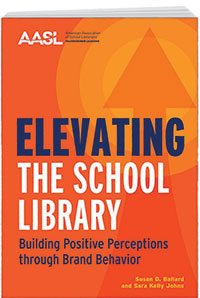
As school librarians, we are always rethinking how to convey who we are and what we do. To compete and remain viable, we need to work on our brand identity.
You might be thinking, “Our school library has a brand?” Most of us associate the word with a name, logo, tagline, and design elements that a corporation uses to distinguish itself from others. It also involves marketing and merchandising to promote the organization’s product or service. When all these components are combined, the result is referred to as brand identity.
The feelings and impressions that members of our school community have when they think of our library, and their memories of interactions they’ve had with us—positive or negative—are our school library’s brand. We need to provide quality products and services, not just say we do. The goal is not so much to transform the school library’s image as it is to build credibility through ongoing improvement and exemplary brand behavior.
Connect with the school community
Brand-building can help undo feelings of marginalization that are familiar to many school librarians. Sometimes it may seem as though the school library exists only at the outer edge of the school or appears to be the victim of benign neglect. This type of disregard may manifest in being ignored by the powers that be, or in our own indifference to situations or things that need attention.
A school librarian may feel marginalized or isolated because of grade-level or department structures that do not provide representation, much less any input into school priorities, needs, and culture. Consider assessing your situation to identify factors that can lead to that kind of sidelining.
One such factor may be a simple lack of understanding of the role of school librarians. If a classroom educator or principal has never viewed the school library as an integral element in developing the educational experience, it is imperative to demonstrate the value that school librarians bring to the table.
The American Association of School Librarians (AASL) provides position statements aimed at improving understanding of school library efficacy by summarizing the library’s role and purpose. Read and internalize the statements’ messages, which can serve as talking points while building your brand with stakeholders.
To educate others about the school library brand, it’s important to be present and become involved in the life of the school and its community. Don’t isolate yourself. Volunteer to serve on committees, participate in school organizations, and assist with school events where you can connect on a different level with learners, parents, and fellow educators.
Work to undo the residual effects of previous negative experiences. At times it may seem that you are dealing with legacy impressions left by the ghosts of school librarians past, or you yourself may have contributed to a situation that now requires some fence-mending.
Whatever the case, set aside your personal feelings and get busy with rebranding. A great place to start is by examining policies and procedures that may be in place to make your life easier but could be onerous to everyone else. You can shift from feeling marginalized to being celebrated when you make others’ lives easier with intention.
Every encounter and transaction should support brand expectations. Take advantage of every opportunity to create a positive memory.
Open up two-way communication channels. Communication involves sharing messaging and regular updates on program impact via reports, displays, newsletters, email, press releases, podcasts, a dynamic web presence, and social media. This could help engage stakeholders and build brand credibility. The best kind of sharing involves communication on a two-way street, with ongoing opportunities for stakeholders to provide input and assess their experiences.
Pondering policies

We should strive for positive interactions in every encounter with our target audiences. Circulation policies are a good place to start, since they affect the outward face of the library.
School librarians often hear that we are the stewards of the library collection and must teach students responsibility. But if we are asked about the most important part of our job, our predominant answer is to increase student literacy. We accomplish this goal by providing access to carefully curated resources in all formats to meet curricular and pleasure reading needs. Overly rigid policies about lost books, overdue fines, and limits on the number of items and length of time that items can be signed out work against that priority, and thus, against a positive school library brand.
Selection policies are also key to brand identity. Having the trust of your administration, colleagues, and most importantly, learners is critical to brand strength. Establishing this trust will assist in building and maintaining a collection of resources that supports curricula, investigates personal interests, and develops lifelong readers.
To maintain an inclusive brand, ensure that learners will see themselves in the books they read. Books with diverse characters and stories must be available at all reading levels and in all genres to fully support learners’ explorations of their physical and emotional development.
As these collection characteristics build, the need for school librarians to have the courage to do the right thing gets clearer. In the face of challenges to books and programs, doing the right thing takes a lot of preparation. School librarians are facing increased scrutiny as individuals and organized groups seek to prevent learners from being exposed to ideas that do not reflect those groups’ beliefs. School librarians must be solid in their professionalism, know their responsibilities and rights, and be collaborative with their districts to prepare for these challenges—ideally before they occur.
A better digital front door
Not having an easy-to-find, user-friendly website that is as prominent as your school library’s front door can be a barrier to cultivating a welcoming brand. First impressions matter, and you need to make a good one.
Your website needs to be discoverable. When a visitor goes to the district website or school landing page, can they immediately find information about the library? Or is the school library page buried several clicks in? Even worse, do they have to use the site’s search tool to find it? Obscurity is a result of neglect, so prioritize addressing this issue.
Next, evaluate the school library website for usability. Your website must be tailored to learners’ interests and their cognitive development, both of which are instrumental to school librarians in their daily interactions with students. The site must be easy for users to navigate. They should be able to find books for schoolwork, personal inquiry, or pleasure reading.
When it comes to contact information, it’s a good idea to include staffers’ names and photos on the website to form welcoming connections. If you want to exclude your email address, consider posting a general library email address, the library’s mailing or physical address, or a phone number.
Review the site’s interactivity. Can students put a book on hold remotely? Can they navigate the website and resources in more than one language? Are their cultures visible, celebrated, and respected on the site?
Your learners—and their parents—need access to resources for research projects through your website. This includes literacy tips to locate, evaluate, and cite sources. Collaborating with classroom educators to curate resource lists for projects also strengthens the school library brand and drives up user statistics, which can get the attention of IT staffers in your school. Better traffic could help prioritize and speed up site improvements, such as easier navigation to the school library site.
Given contemporary graphic design programs and free-to-use photos, it’s not difficult for school library websites to have visual appeal and representation for all learners. Younger students have been shown to respond best to big, colorful icons and buttons, whereas high schoolers need the website to provide immediate access to high-quality information in all formats. Your website should reflect and share the vibrancy of your school library and its learning community as you build your brand both physically and virtually.
The goal is to build credibility through ongoing improvement and exemplary brand behavior.
Evaluate physical spaces
What are some indicators that show the school library facility is either diminishing or elevating the brand experience for someone? Is the library a place where learners and educators want to be? What physical, intellectual, and time barriers need to be addressed?
A helpful guide to overcoming these barriers is AASL’s National School Library Standards for Learners, School Librarians, and School Libraries. The standards recommend focusing on aligning your school or district goals and objectives with your school library vision and mission, rather than ending up with a cookie-cutter version of what someone else thinks a school library should be.
One of the best quality-control checkpoints for any brand and its facilities is to place yourself in the shoes of the customers. Simulate their experience to better understand what they encounter during an interaction with your library.
Real-life user experience merits close attention. This is why homeowners are advised to spend a night in their guest room or try sleeping on the pull-out couch, futon, or air mattress they have provided for visitors. The same practice holds true for the school library. We want everyone to consider the library as the greatest place in the school. We don’t ever want to hear that they’ll never be back because the environment was unaccommodating.
While the primary purpose of signage is to help direct and inform visitors in a space, it can also indicate empathy and understanding of the end-user experience. For example, the school library often limits food or beverages in the facility. Instead of a sign that says no eating or drinking, signage with messaging like this may be more effective: the library is a no-food zone, but you are welcome to have water except around computer stations and other electronics to prevent damage to our equipment.
Although we know that library layouts and furnishings need to be flexible and ADA compliant, an effective way to reimagine the space is to identify different learning zones and create a facility footprint. Such zones would include areas for the collection and technology as well as a variety of seating, workspace, and sound options. Focus on how people work, what environments they respond to, and how they interact in those environments to inform your layout.
Intellectual access is as critical as any other kind. How the school library collection is organized communicates something about your brand. Some questions to ask:
- Is it organized by Dewey Decimal Classification, genre, or a mix of both? For whose benefit?
- Are physical resources arranged in a way that is appealing and markets the collection? Or is there a reason to maintain a more traditional library look?
- Has a standard system and nomenclature been adopted throughout a school district or campus to ensure discoverability and a fluid transition from one school level to another? Or is this system left to individual or school preferences?
- Are the needs of non-native English speakers and readers and those who are differently abled considered in the mix?
Scheduling is another tricky issue in all schools. Administrators may need the space for nonlibrary use, such as testing, school pictures, study hall, or detention. This can impede access for others. Implications for your school library brand can also arise when schedules are designed solely for teacher preparation or limited to formal classes and instruction without accounting for individual use and needs.
AASL’s Position Statement on School Library Scheduling clearly identifies what must be addressed to help eliminate scheduling barriers and improve facility access for all.


